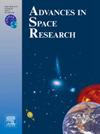对 100 TeV 以下宇宙射线核子频谱的局部影响
IF 2.8
3区 地球科学
Q2 ASTRONOMY & ASTROPHYSICS
引用次数: 0
摘要
最近对初级和次级 CR 光谱及其到达方向的测量,以及我们对日光层周围磁场几何形状的进一步了解,使我们能够确定一个令人费解的 10-TeV "凸起 "和某些相关光谱特征的起源距离。与 "凸起 "相关的光谱断裂的尖锐性、横跨本地磁赤道(俯仰角)的 CR 强度的突然变化,以及主 CR 和次 CR 光谱模式之间的相似性,都表明 "凸起 "粒子从背景 CR 中脱离后,在本地进行了再加速。我们认为,由于先前存在陡峭的CR频谱,附近的冲击可能会在50TV以下的范围内将粒子的刚度提高1.5倍,从而产生这种撞击。低于 0.5 TV 的再加速粒子与星际介质流对流,不会到达太阳。高于这个刚度的粒子就形成了凹凸。在刚度低于 100 TV 的范围内,所有 CR 核(原生核和次生核)的光谱特征都是由这一单一的普遍过程造成的。我们认为一个可行的候选者是与太阳 3.2 pc 处的 Eridani 星相关的冲击系统,它与当地磁场的方向完全一致。其他冲击,如老的超新星外壳,也可能产生类似的效应。我们展示了我们的形式主义是如何预测氦、硼、碳、氧和铁光谱的,这些光谱在 GV-TV 范围内都有精确的数据。因此,我们的模型统一了在 50 TV 以下观测到的所有 CR 光谱特征。本文章由计算机程序翻译,如有差异,请以英文原文为准。
Very local impact on the spectrum of cosmic-ray nuclei below 100 TeV
Recent measurements of primary and secondary CR spectra, their arrival directions, and our improved knowledge of the magnetic field geometry around the heliosphere allow us to set a bound on the distance beyond which a puzzling 10-TeV “bump” and certain related spectral features cannot originate. The sharpness of the spectral breaks associated with the bump, the abrupt change of the CR intensity across the local magnetic equator ( pitch angle), and the similarity between the primary and secondary CR spectral patterns point to a local reacceleration of the bump particles out of the background CRs. We argue that, owing to a steep preexisting CR spectrum, a nearby shock may generate such a bump by boosting particle rigidity by a mere factor of 1.5 in the range below 50 TV. Reaccelerated particles below 0.5 TV are convected with the interstellar medium flow and do not reach the Sun. The particles above this rigidity then form the bump. This single universal process is responsible for the observed spectral features of all CR nuclei, primary and secondary, in the rigidity range below 100 TV. We propose that one viable candidate is the system of shocks associated with Eridani star at 3.2 pc of the Sun, which is well aligned with the direction of the local magnetic field. Other shocks, such as old supernova shells, may produce a similar effect. We provide a simple formula that reproduces the spectra of all CR species with only three parameters uniquely derived from the CR proton data. We show how our formalism predicts helium, boron, carbon, oxygen, and iron spectra, for which accurate data in GV-TV range exist. Our model thus unifies all the CR spectral features observed below 50 TV.
求助全文
通过发布文献求助,成功后即可免费获取论文全文。
去求助
来源期刊

Advances in Space Research
地学天文-地球科学综合
CiteScore
5.20
自引率
11.50%
发文量
800
审稿时长
5.8 months
期刊介绍:
The COSPAR publication Advances in Space Research (ASR) is an open journal covering all areas of space research including: space studies of the Earth''s surface, meteorology, climate, the Earth-Moon system, planets and small bodies of the solar system, upper atmospheres, ionospheres and magnetospheres of the Earth and planets including reference atmospheres, space plasmas in the solar system, astrophysics from space, materials sciences in space, fundamental physics in space, space debris, space weather, Earth observations of space phenomena, etc.
NB: Please note that manuscripts related to life sciences as related to space are no more accepted for submission to Advances in Space Research. Such manuscripts should now be submitted to the new COSPAR Journal Life Sciences in Space Research (LSSR).
All submissions are reviewed by two scientists in the field. COSPAR is an interdisciplinary scientific organization concerned with the progress of space research on an international scale. Operating under the rules of ICSU, COSPAR ignores political considerations and considers all questions solely from the scientific viewpoint.
 求助内容:
求助内容: 应助结果提醒方式:
应助结果提醒方式:


